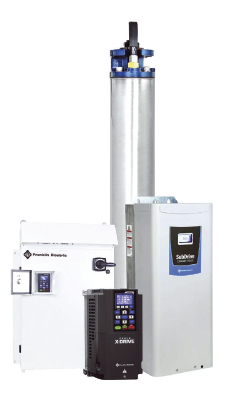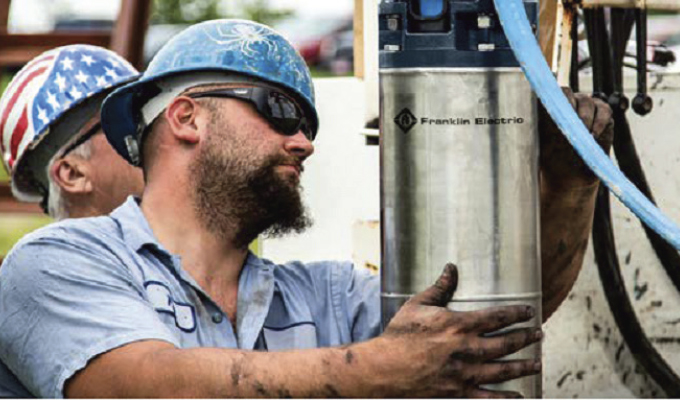Read part 1 here.
In part one of this series, we discussed some of the many factors that can improve return-on-investment (ROI) time, increase sustainability, and boost productivity—with an emphasis on a growing solution for delivering higher efficiency with proven reliability: a pumping system built around a permanent magnet (PM) motor. Below, let’s explore more of the benefits PM motors can provide across different applications.
SUSTAINABILITY
The earlier benefits listed in this series deliver cost savings that also add up to more overall sustainable operation. Lower electrical usage saves money for users, but also reduces the carbon footprint associated with the application. For example, in the mining dewatering setting operating at 12 hours per day, the mine site personnel observed an annual carbon dioxide reduction equivalent to 32.3 tons in a year—and avoided paying for nearly 42,000 additional kilowatt-hours. In the municipal setting running 100 horsepower equipment 10 hours per day, the energy efficiency improvements obtained by switching to this technology would be equivalent to replacing more than 304 incandescent bulbs (60W) with LEDs every year. Another way to look at it is the additional power required for the induction system is roughly 13.5 tons of carbon. According to the EPA it would take almost 15 acres of forest to sequester the added carbon dioxide every year.
In addition, PM motor systems offer quieter operation to reduce noise pollution when compared to above-ground pumping sets, minimizing their impact on people and the surrounding environment. Working hand-in-hand with sustainability is resiliency, or the ability to adapt and overcome unforeseen environmental conditions. For example, with the effects of climate change and warmer temperatures, many drillers are having to go deeper to access groundwater. In Dallas, groundwater used to reside at 600 feet and now must be pulled greater than 1,000 feet. In Lubbock, Texas a pivot irrigation sprinkler used to be supplied by three wells and now requires over ten wells. These situations equate to additional energy requirements that could be partially or completely offset with PM motors.
PROVEN PERFORMANCE IN SUBMERSIBLE APPLICATIONS
PM motors provide considerable benefits in submersible applications over induction motors. If you are currently running an induction motor in a submersible pump and replace it with a PM motor, the PM motor will win every time in terms of less overall cost of ownership, more efficient operation, better performance and less downtime. Consider the following:
- Permanent magnet motors run with an efficiency rate of about 90 to 94 percent.
- Permanent magnet motors deliver better performance across a range of speeds for longer motor life and better overall performance.
- Permanent magnet motors operate with no slip: in contrast with standard induction construction, their speed is constant regardless of load, delivering consistent water distribution.
- When paired with a pump in submersible installations, PM motors offer higher efficiency operation and speed compared to other pumping systems that rely on induction motors.
These are just the beginning of the benefits owners and operators experience with PM motor technology. It is also an efficient alternative to vertical line shaft turbines and submersible systems powered by traditional induction motor designs.

BETTER SYSTEM PERFORMANCE
PM submersible motors typically have four poles, whereas an induction motor will rely on two-poles. This requires the motor to run at 120 Hz to achieve 3,600 RPM. VFDs are the only suitable motor control device that will allow a motor to run above the power line frequency. Today, more full-service manufacturers offer reliable solutions that range from 4-inch motors up to 300 horsepower using 10-inch submersible motors.
As technology progresses, manufacturers have also come a long way in providing cost-effective solutions that are built around variable frequency drives (VFDs) engineered to operate with both induction and PM technology rather than custom ones. This also delivers versatility and allows the units to serve multiple industries, applications, and job requirements, such as:
- In general, varying the speed of the motor and pump based on demand.
- Built-in lead/lag and alternation capability make them an ideal solution for simple or multi-pumping systems.
- Phase conversion
Select VFDs are optimized to seamlessly be paired and perform with PM motors. In the past, variable frequency for these types of installations led to an intimidating and complex setup process; now, new solutions have been engineered to deliver ease-of-use. In some cases, you might experience a setup that feels as intuitive as installing a plug-and-play drive.
VFDs are the most popular electronic device used to vary the speed of a pump, and for good reason. PM motors have no slip and are designed to run with a synchronous speed at their rated voltage. This means you are not compromising speed for efficiency. When running a PM motor with a VFD, you can enhance and expand your pump envelope by gaining optimized efficiency. A PM motor paired with a VFD delivers not only energy savings and protection but also advanced speed control and soft start that maximizes the system’s life and mitigates maintenance costs throughout its lifespan. In addition, VFDs that have been optimized and designed for water systems will support the prevention of a dry-well scenario, protect against pipe leaks and electrical surges, and reduce stress on plumbing thanks to its pipe-fill mode.
COMPATIBILITY AND SCALABILITY
High efficiency pumping systems with PM motors are offered in a variety of sizes and can easily grow with a user’s needs. Getting the system from one manufacturer can help with this compatibility and scalability. A single system manufactured and shipped from a single source will allow for simple startup, compatibility with a variety of application types, optimized performance and extended system life. Some offer service options to ensure users are backed up for sizing and selection as well as setup. In terms of scalability, users do not have to compromise efficiency when the system needs to grow.
CONCLUSION
Pumping systems that utilize a PM motor are becoming more widespread, due in part to their functionality across a wider range of pumping application needs. When paired with a VFD, they offer easy set up features and optimized operation, helping owners and operators benefit from more efficient system operation and cost savings that continue to add up throughout the entire lifecycle of the system.
FOR MORE INFORMATION
From groundwater to water treatment and more, Franklin Electric’s diverse product portfolio, combined with industry-leading technical support and service tools, helps save customers time and money. Franklin Electric is a global leader in the production and marketing of systems and components for the movement of water and energy. Recognized as a technical leader in its products and services, Franklin Electric serves customers around the world in residential, commercial, agricultural, industrial, municipal, and fueling applications. For more information, visit www.franklinwater.com.
MODERN PUMPING TODAY, December 2023
Did you enjoy this article?
Subscribe to the FREE Digital Edition of Modern Pumping Today Magazine!


